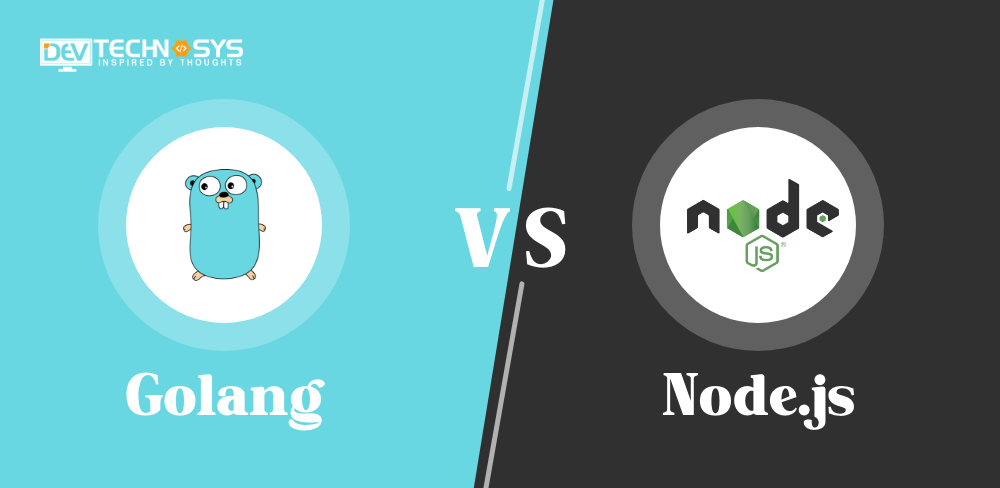For web development, a wide variety of programming languages are accessible. Golang and Nodejs are two of the most popular options. Which one would you choose for your next project then? In 2023, both Golang vs Node js will be growing technologies.
Golang is an easy-to-read and easy-to-write language with powerful syntax. It is fast, efficient, and a good choice for large-scale projects.
Nodejs, on the other hand, is a runtime for JavaScript. This is a versatile language that can be used both in front-end as well as back-end development. It’s also easy to learn and there is a wide community of developers who can help you.
Both are popular, the question is who wins the war between Golang and Nodejs? Here is a list of the main differences between the two languages to help you answer the question. Find out which language is best for your project by reading on!
What is Golang?
Golang is also a programming language developed by Google. The language is statically typed, with a syntax that is loosely derived from C. It also has additional features like garbage collection, type safety, and dynamic typing capabilities. It is designed to make large distributed systems simple, efficient, and scalable.
Go’s concurrency support enables programmers to create applications that execute numerous tasks concurrently. It is also easy to use and learn for developers who come from other languages. The small standard library means that it is not suitable for many tasks such as connecting with a database or making HTTP requests.
What is Nodejs?
Nodejs, an open-source JavaScript environment, executes JavaScript outside of the web browser. It was designed to create scalable network apps and is especially well-suited for real-time applications that require high concurrency.
Because of its event-driven, non-blocking I/O approach, Nodejs is compact and effective. It’s a great choice for creating data-intensive, real-time, distributed applications.
Nodejs uses the V8 JavaScript Engine, the same engine as Google Chrome. It is used to build server-side applications but also for command-line tools, desktop applications, and creating desktop applications.
Golang vs Node Js-Advantages
Advantages of Golang
- Easy and Fast
Golang’s speed is its first and foremost benefit. It does not require an interpreter and can be directly converted to machine code. It is faster to develop the backend because there is no middleman. It is also easy to learn and implement because it has a simple set of code.
- Community Support
Even though Golang is not a new language, it has been around for quite some time. Its stable release was in 2019. There are still more than 1 million developers who are willing to help with any aspect of the web development process.
- Comprehensive Tools
Golang provides a range of tools that are comprehensive, such as an inbuilt framework for testing, a linter, and other tools to perform static analysis. It also offers IDEs, like Visual Studio Code, which help developers work more efficiently. Golang has a built-in source formatting tool.
- Garbage Collection
Golang’s automatic memory management allows you to focus on other aspects of your development process, without impacting performance. Garbage collection is a concern for some developers. However, the productivity and results outweigh this minor inconvenience.
- Compatibility
Golang was developed with the past in mind. The programs developed in Golang are backward compatible, meaning that future versions of Golang can be used with apps developed using the current version.
- Scalability
Goroutine functions in Golang can be run concurrently and freely. Golang can scale up to 2kB of memory. Goroutines combine JavaScript async with Java’s multithreading classic method. They allow you to run multiple Goroutines and not worry about system crashes.
Advantages of Nodejs
- High Performance and Efficiency
Nodejs interprets the code using Chrome’s V8 Engine. The event-driven architecture and single module caching of Nodejs allow for concurrent requests to be made without impacting RAM. Its I/O and event loop operations allow faster code execution. This reduces response time and boosts performance.
- Cross-Platform Support
Nodejs enables cross-platform application development. With relatively few changes, the same code may be executed on other systems.
- Scalability
Nodejs is a single-threaded system with an event loop. This mechanism helps servers respond in a nonblocking way and promotes scaling. This single-threaded program is very scalable since it can handle several requests at once.
- Packages
Nodejs offers a large collection of Nodejs Packages that are open-source and available to everyone. These packages help to speed up and simplify development. Nodejs’s NPM ecosystem has over a million packages.
- Event-driven and Asynchronous
Nodejs library provides asynchronous and non-blocking APIs. This means that the server can continue to call the next API after calling the previous API. The notification mechanism for events is used to receive the response from the previous API.
Golang vs Nodejs-Disadvantages
Disadvantage of Golang
- Lack of Generics
Go does not have generics. This can make code more complex and harder to reuse. Developers are forced to use type conversions and assertions without generics. This leads to more verbose code.
- Immature Ecosystem
In comparison to comparable language ecosystems like Java or Python, the Go ecosystem is still very young. It is possible that there are fewer libraries or tools for certain tasks. Even though the ecosystem is rapidly growing, it may still be difficult to find readymade solutions for niche needs.
- Error Handling
Go’s explicit error handling is done with return values. This can result in verbose, repetitive code for error checking throughout the application. This approach can result in code that is cluttered and difficult to read, even though it promotes error propagation.
- Limitation of the Standard Library
While Go’s library is comprehensive and well-designed it may not include all functionalities needed for certain specialized tasks. In these cases, developers may need to rely upon third-party libraries that can vary in quality, stability, and maintenance.
- Lack of Language Feature
Go was created with simplicity in mind. Because of this, it’s possible that some sophisticated capabilities of other programming languages are not available. For instance, Go is deficient in sophisticated features like function overloading and default function parameters. This can be restrictive to dedicated developers used to more expressive programming languages.
Disadvantages of Nodejs
- Single-Threaded
Nodejs is a single-threaded model. This means that it can only process one request at a given time. This design is great for I/O intensive tasks but can be a problem for CPU-bound ones. Nodejs is not the best choice for applications that require extensive CPU processing.
- Callback Hell
When dealing with asynchronous operations, “callback hell”, as it is called, was one of the first challenges that Nodejs faced. Multiple callbacks nesting can result in complex code that is hard to read. This issue can be mitigated by using Promises, Async/Await, or a third-party library, but it still requires good coding practices in order to maintain code readability and avoid excessive nesting.
- Limited Standard Library
Nodejs has a limited standard library. While it provides a comprehensive library for network applications, the library is more restricted for general-purpose tasks. Developers may have to use external libraries for certain functionality, such as image processing and data manipulation. This can increase complexity and development time.
- Scalability Challenges
Nodejs’s scalability can be a problem when dealing with large applications that require heavy computation. Nodejs is a single-threaded application, so a CPU-intensive task can cause the event loop to be blocked, causing all other incoming requests to wait. This can affect performance and responsiveness.
- Maturity of the Ecosystem
Although the Nodejs ecosystem has grown considerably over the years, you can still consider it relatively young compared with other programming languages. The stability, quality, and maintenance of modules and libraries from third parties can be variable. The developers should evaluate their dependencies and make sure they are maintained actively and have robust support from the community.
Golang vs Nodejs-Key Difference
| Elements | Golang (Go) | Nodejs |
| Language | Compiled language | Interpreted language |
| Performance | Efficient and fast execution | Moderate performance |
| Concurrency | Built-in support for goroutines and channels | Single-threaded with event-driven, non-blocking I/O |
| Scalability | Built-in support for concurrent programming | Requires external libraries for concurrent operations |
| Syntax | Static typing with type inference | Dynamic typing |
| Package Manager | Go modules | npm (Node Package Manager) |
| Ecosystem | Smaller but growing ecosystem | A large and mature ecosystem |
| Error Handling | Requires explicit error handling | Supports both explicit and implicit error handling |
| Networking | The standard library provides robust networking capabilities | Extensive libraries and frameworks for networking |
| Learning Curve | The relatively steeper learning curve for beginners | The easier learning curve, especially for JavaScript devs |
| Use Cases | System programming, networking, distributed systems | Web servers, APIs, real-time applications |
Golang vs Nodejs-Detailed Comparison
1. js vs Golang: A Comparison of Performance and Speed
Golang has an edge when it comes to raw speed and performance. Golang is not an interpreter but is assembled directly into machine code. Golang has a performance level similar to the low-level language C++. Golang performs as well as Nodejs when it comes to IO operations.
Nodejs is slightly behind Golang when it comes to performance. Nodejs is a single-threaded performance that is improved by the optimized and improved version. The V8 JavaScript Engine ensures that the application can run without the need for an interpreter.
Verdict: Nodejs and Golang are on par when it comes to Nodejs vs Golang
2. Golang vs Nodejs Comparison Based on Concurrency & Scalability Parameters
Nodejs handles concurrency using APIs like clusters, worker_thread, and child_process. These APIs ensure that Nodejs can handle all incoming requests efficiently and without bottlenecks.
Golang, on the other hand, is designed to handle all tasks simultaneously. Go developers use GoRoutines for their multi-threaded functionality. They don’t use much RAM. This makes Go the best and most reliable choice for managing complex and intensive tasks, without compromising other functions. Go beats Node. Scalability is a key factor for js.
Verdict: Golang is the winner in the concurrency and scalability battle between Nodejs and Go.
3. Golang vs Nodejs for Error Handling
The Error Handling Method of Nodejs is ideally known by most developers. It implements a try-catch error where errors are immediately caught and handled during runtime. The process with Golang is slightly different. Golang handles errors differently during compilation and runtime.
Runtime errors require explicit handling. Compilation errors are typically syntax related and can be corrected within the code. This function’s return value must be manually checked. The current study is to improve the handling process in Golang’s upcoming version.
Verdict: Nodejs is similar to Golang. It’s a TIE.
4. Development Tools Comparison Between Golang vs Nodejs
In general, the availability of tools that are ready to use reduces development time. Over 836,000 open-source libraries and tools are accessible to Nodejs developers using NPM. There is no shortage of Nodejs tools, but choosing the right ones can prove difficult.
Golang doesn’t have a lot of options when it comes to tools, but its standard library is robust. The tools available in Golang are usually limited. Each tool is designed to make Golang programming simpler. Golang Test, for example, allows developers to run tests on code and the Golang Vet filters out suspicious or unusual constructs.
Verdict: Nodejs is the winner in terms of volume.
5. Golang vs Nodejs: Community Comparison
Nodejs Foundation is supported by Microsoft, Intel, and IBM. In 2018, Nodejs downloads usually exceeded 1 billion. This shows how quickly the Nodejs Community is growing. Nodejs is widely used by the community.
Golang’s popularity is on the rise. Nodejs has 83.5k stars, while Golang has 93k. Open pull requests in both Nodejs and Golang are very similar. Nodejs, however, has 24000 closed pull requests while Golang only has 1200. The fan bases of the two technologies are not equal.
Verdict: Nodejs is the winner in the Node vs Go Community Comparison
6. Which One Has a More Straightforward Learning Curve Between Golang vs Nodejs?
Nodejs has a lower learning curve than Golang because JavaScript is widely used. Nodejs is a language that has a lower learning curve than Golang, mainly because JavaScript is already widely used. It is therefore very easy for programmers to learn the language. The learning curve for Golang is steeper than Node.
Verdict: Nodejs has a much simpler learning curve than Golang.
Golang vs Nodejs-Which is Here to Stay?
Nodejs achieved ninth place and Go tenth as the most popular programming languages, respectively, in the Stack Overflow Developer Survey, 2021. According to a 2018 Nodejs Market Share Report, 68% of developers and managers believe that Nodejs is essential for improving developer productivity. The usage of Go modules, on the other hand, increased by 86% between 2021 and 2019, which was only 41% in 2019.
These statistics intensify the Node JS vs Golang discussion but also show that both technologies will be around for a long time. Nodejs may have already captured a large market share but Golang’s support from Google promises a brighter future.
Conclusion
It’s difficult to decide which technology is best based on the above analysis. This blog aims to provide you with some insight into the technology that will work best for your project, or which aligns well with your business’s culture. We hope this blog has helped you to decide between Golang vs Nodejs. Therefore, if you want to build a website using these technologies, then it would be better to consult a Golang development company.























